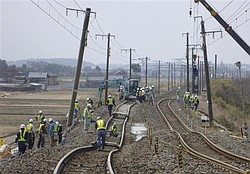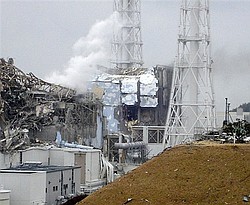Japan to spray water, acid on nuke plant
AP
This image made available from Tokyo Electric Power Co. via Kyodo News, shows the damaged No. 4 unit of the Fukushima Dai-ichi nuclear complex in Okumamachi, northeastern Japan, on Tuesday March 15, 2011. White smoke billows from the No. 3 unit.
AP Photogallery | Earthquake aftermath

Workers repair the railway tracks damaged by the March 11 earthquake in Hitachinaka, Ibaraki Prefecture, Japan, Monday, March 21, 2011. (AP/Yukie Nomura)
Associated Press
KORIYAMA, Japan
Japan was considering spraying water and boric acid over a stricken nuclear plan in a desperate measure to contain radiation after officials said today that many fuel roads were damaged, in an escalating crisis caused by last week’s earthquake and tsunami.
Masami Nishimura, a spokesman for Japan’s nuclear safety agency, said the plant’s operator, Tokyo Electric Power Co., thought of the measures after a string of explosions and fires at the Fukushima Dai-ichi nuclear power plant.
The latest fire broke out at a reactor early today, a day after the power plant emitted a burst of radiation that panicked an already edgy Japan after Friday’s massive earthquake and tsunami that is estimated to have killed more than 10,000 people.
Hajimi Motujuku, a spokesman for Tokyo Electric Power, or TEPCO, said the outer housing of the containment vessel at the No. 4 unit at the complex caught fire.
Also today, Japan’s central bank injected billions of dollars into financial markets for a third day to ease the impact of last week’s quake.
The Bank of Japan injected $43 billion into markets today. That came after injections totalling $283 billion over the past two days.
On Tuesday, a fire broke out in the same reactor’s fuel storage pond — an area where used nuclear fuel is kept cool — causing radioactivity to be released into the atmosphere. TEPCO said the new blaze erupted because the initial fire had not been fully extinguished.
About three hours after the blaze erupted today, Japan’s nuclear safety agency said flames no longer could be seen at Unit 4. But it was unable to confirm that the blaze had been put out, and clouds of white smoke were billowing from the reactor, according to live video footage of the plant.
Also today, Japan’s nuclear safety agency said 70 percent of the nuclear fuel rods may have been damaged at another Fukushima Dai-ichi reactor that was first stricken last week, triggering the crisis.
Japan’s national news agency, Kyodo, said 33 percent of the fuel rods at a second reactor also were damaged.
The troubles have been caused by overheating of the reactors, which have lost their cooling ability because of damage to equipment from the earthquake and tsunami. Excessive heating will lead to a meltdown of the reactor and release hazardous radiation.
Engineers are desperately trying to cool the reactors and spent fuel rods after the electricity was cut off in the wake of the quake, shutting down their cooling functions.
Boric acid is “important because it captures radiation and helps prevent radiation from leaking,” said Nishimura, the safety agency spokesman. He said the government ordered the utility company to immediately spray water on Unit 4.
Boric acid contains boron, which helps slow nuclear reactions by absorbing neutrons, said Naj Meshkati, a nuclear power plant safety expert at the University of Southern California. But the same acid also melted away steel when it was used repeatedly at a troubled northern Ohio nuclear plant.
 43
43

